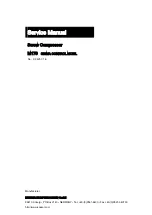
8
Part # 25000102
In systems equipped with capacity control compressors,
or where multiple compressors are used with one or more
compressors cycled off for capacity control, double suction
risers should be installed. See Figure 6 below. The two
lines should be sized so that the total cross-section area
is equivalent to the cross section area of a single riser that
would have both satisfactory gas velocity and acceptable
pressure drop at maximum load conditions. The two lines
normally are different in size, with the larger line trapped as
shown. The smaller line must be sized to provide adequate
velocities and acceptable pressure drop when the entire
minimum load is carried in the smaller riser.
•
In operation, at maximum load conditions gas and
entrained oil will be flowing through both risers. At
minimum load conditions, the gas velocity will not be
high enough to carry oil up both risers. The entrained oil
will drop out of the refrigerant gas flow and accumulate
in the “P” trap forming a liquid seal. This will force all of the
flow up the smaller riser, there by raising the velocity and
assuring oil circulation through the system.
When connecting more than one suction line to a main
trunk line, connect each branch line with an inverted trap.
See Figure 7 below:
•
•
Straight runs should be supported near each end.
Long runs require additional supports.
A general guide is:
3/8” to 7/8” every 5 feet
1-1/8” to 1-3/8” every 7 feet
1-5/8” to 2-1/8” every 10 feet
When changing directions, supports should be placed a
maximum of 2 feet in each direction.
Piping attached to a vibrating object (such as a compressor
or compressor base) must be supported in such a manner
that will not restrict the movement of the vibrating object.
Rigid mounting will fatigue the copper tubing.
Use only a suitable silver solder alloy on suction and liquid
lines.
Limit the soldering paste or flux to the minimum required
to prevent contamination of the solder joint internally. Flux
only the male portion of the connection, never the female.
After brazing, remove excess flux.
•
•
•
•
•
•
•
•
•
•
Installation and Operations Manual
When brazing refrigerant lines, an inert gas should
be passed through the line at low pressure to prevent
scaling and oxidation inside the tubing. Dry nitrogen is
preferred.
Use long radius ell’s for lower pressure drop.
Provide expansion loops in long straight refrigerant
lines that are subject to expansion and contraction. See
Expansion Loops in this manual for more information.
Refrigerant Line Insulation
Insulate suction lines from the evaporators to the parallel
unit with minimum 3/4” thickness closed-cell type
insulation on low temperature circuits. Insulate suction
lines on medium temperature circuits with minimum 1/2”
thick insulation to prevent condensation.
Long liquid lines run in areas exposed to high temperatures
should be fully insulated with minimum 1/2” insulation.
Suction and liquid lines should never be taped or
soldered together.
Refrigerant Line Support
Strap and support tubing to prevent excessive line
vibration and noise. All tubing clamps should have an
insulating material (i.e. Hydra Sorb bushing) to prevent
metal to metal contact.
•
•
•
•
•
•
•
Figure 6. Double Suction Risers
Figure 7. Inverted Trap
Figure 8. Pipe Support









































